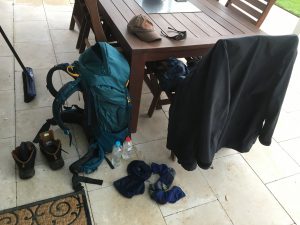This afternoon I went for a training hike in the pouring rain. It was cold, the wind on Willunga Hill was fierce and I even got battered by hail at one stage. Many people would think this is crazy. It’s much better to wait for favourable conditions to train in, right? Not necessarily. I made a couple of important discoveries during my training session.
I found out that my rain jacket, just over two years old now, is in serious need of an application of some waterproofing spray. Though it did not leak and the sealed seams are all intact, the outer layer quickly became waterlogged. Over time and with extensive wear, a garment loses its capacity for water to “bead” and run off like it did when the item was new. This makes it heavy, cold and less comfortable to wear. Applying a spray on waterproofing agent can greatly enhance the garments performance.
The situation with my boots, which are the same age as the jacket though they have endured much more wear, is more critical. It seems the membrane in the boots has deteriorated to the point where they are no longer waterproof. Sadly, even though they are still quite serviceable in fine weather, these all-time favourites will have to be replaced.
The thing is though, if I’d waited for better training conditions, I wouldn’t have come to these important conclusions.
At this stage in our preparation, the new members of our team are (hopefully) busy shopping for equipment. Even the old hands will no doubt be tweaking their kit to some degree. Buying equipment is fun, but you are not truly prepared until you put your gear through some serious testing.
One of the most under-rated (in my opinion) parts of our hike preparation is the requirement to go on at least two practice overnight training camps. These practice runs can lead to valuable insights, particularly if your gear is really tested by unfavourable conditions. There are a whole range of questions which can only be answered through testing yourself and your equipment. Do you need a silk liner to stay warm in your sleeping bag when it’s really cold? Does the floor of your tent alone provide adequate insulation when the ground is cold or wet? How much extra weight are you carrying when your backpack becomes waterlogged? How much longer (and how much extra fuel) does your cooker take to bring water to the boil when it’s cold? What type of hat best protects you from the sun without overheating you? What clothing combination do you prefer for hiking in changeable weather conditions? How much water do you need to carry on a hot day?

Equipment after a serious test run!
Spencers Creek and Happys Hut (first night of our KNP hike) are not the places where you want to find out your tent leaks or your clothing doesn’t perform as expected. Of course the manufacturer and the salesman claimed your gear was up to the task. But how will you really know unless you put it through a searching test run or two? It sounds very appealing to wait for a nice balmy summer night to do an overnighter. But your gear might not truly get tested.
In another month or so, we’ll all be resigned to a long, hot summer of training. Considerations such as waterproofness, windproofness and warmth can easily be forgotten about.
Now might be the time for some serious equipment testing!
Craig
22/9/19.
